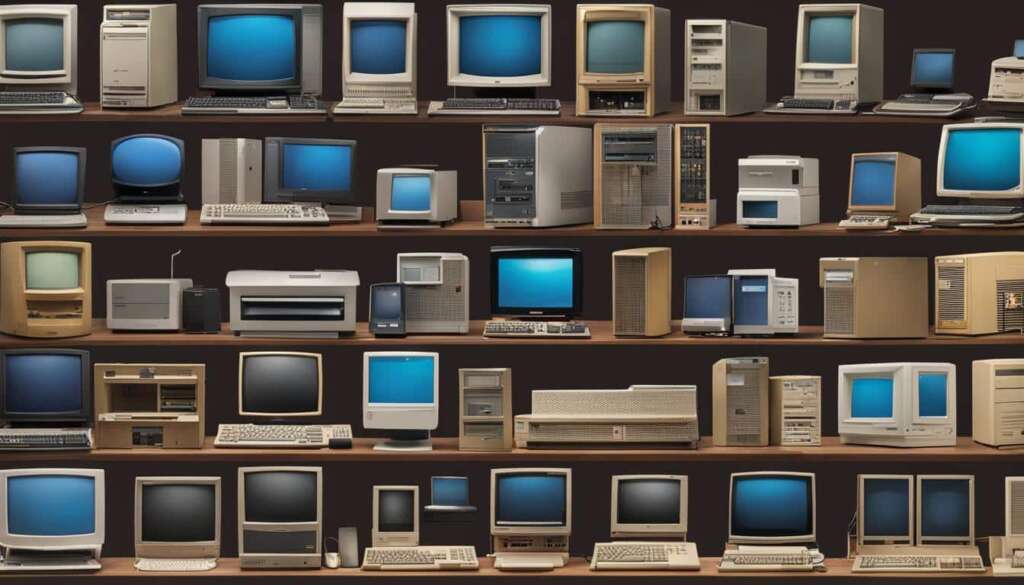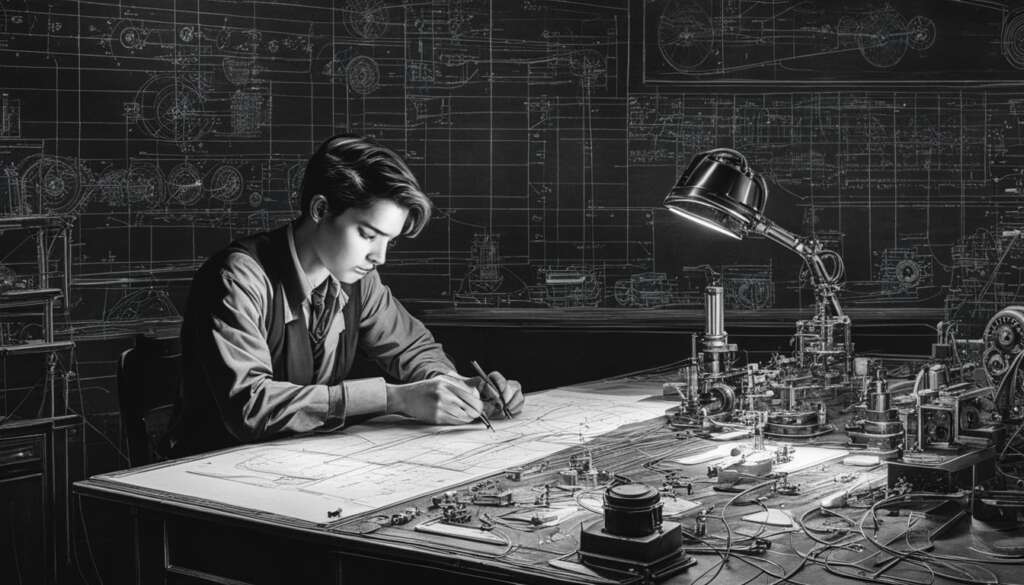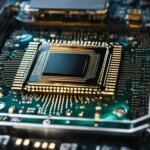Table of Contents
The evolution of computers has been a fascinating journey, showcasing the remarkable progress and innovation in the field of computing. From its humble beginnings in the 1800s to the powerful systems we have today, computers have revolutionized various industries and transformed the way we live and work. Let’s take a closer look at the milestones in computer evolution and the technological advancements that have shaped the computer industry over the years.
Key Takeaways
- The evolution of computers traces back to the 1800s, with early mechanical computers like Charles Babbage’s Analytical Engine.
- Electro-mechanical computers emerged in the 1930s, utilizing relays and vacuum tubes.
- The 1940s marked the development of electronic computers, with notable examples such as Colossus and ENIAC.
- The 1950s saw the introduction of the first commercially available computers, including LEO and UNIVAC.
- The 1960s witnessed the advent of microchips and microprocessors, revolutionizing computer technology.
1800s-1930s: Early Mechanical Computers
In the 1800s to the 1930s, the world witnessed the development of early mechanical computers that laid the foundation for modern computing. One notable pioneer in this era was Charles Babbage, who designed the groundbreaking Babbage Engines. These machines included the Difference Engine, designed to perform mathematical calculations, and the Analytical Engine, considered the first programmable computer. Although these ambitious projects were never fully completed, they introduced revolutionary concepts that shaped the future of computing.
Another significant development during this period was the creation of Konrad Zuse’s Z1, one of the first automatic computing machines. Built in 1938, the Z1 utilized mechanical internals for calculations, marking a significant leap in computer technology. These early mechanical computers paved the way for the programmable and automatic machines that would later become the backbone of the computing industry.
To summarize:
- Early mechanical computers emerged from the 1800s to the 1930s
- Charles Babbage’s Babbage Engines introduced the concepts of programmable computers
- The Z1, created by Konrad Zuse, was one of the first automatic computing machines
| Babbage Engines | Konrad Zuse’s Z1 |
|---|---|
| The Difference Engine and Analytical Engine | One of the first automatic computing machines |
| Pioneered concepts of programmable computers | Utilized mechanical internals for calculations |
1930s: Electro-Mechanical Computers
In the 1930s, a significant milestone in computer evolution was the emergence of electro-mechanical computers. These machines utilized relays and vacuum tubes as switches, marking a shift from purely mechanical operation to incorporating electronic components. The introduction of these technologies enabled faster and more reliable calculations, propelling the development of computing systems.
One noteworthy electro-mechanical computer of this era was the Differential Analyzer, which employed a series of electric motors to perform calculations. This analog computer was used for tasks such as solving differential equations, a valuable tool in scientific research and engineering. Another key development during this period was the creation of both analog and digital computers, such as the Model K and Complex Number Calculator.
The impact of electro-mechanical computers cannot be understated. These early computing machines laid the groundwork for the modern computer industry, setting the stage for further advancements in technology. By combining mechanical and electronic components, electro-mechanical computers paved the way for more sophisticated computing systems that would transform industries and revolutionize the world.
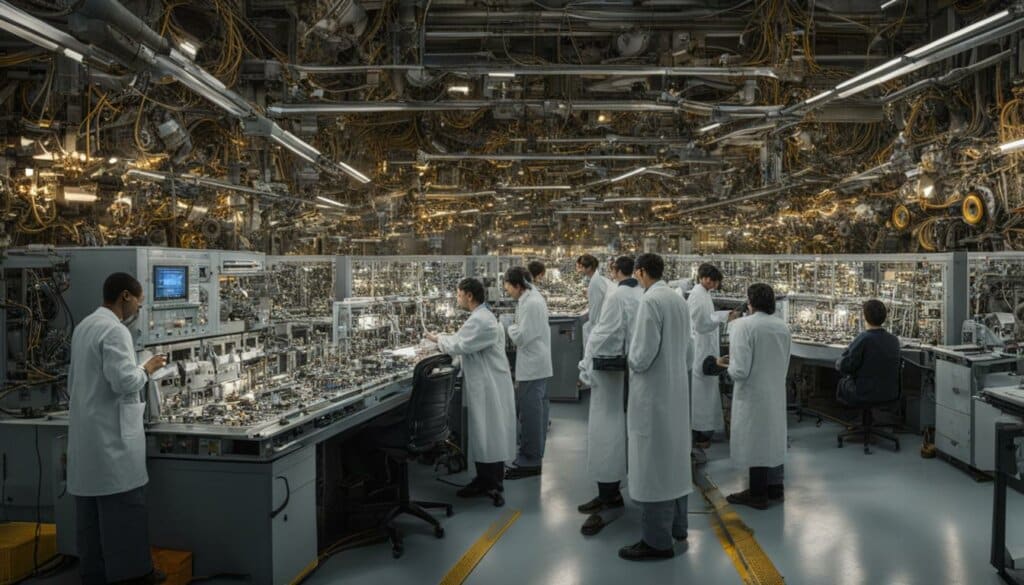
Table: Comparison of Analog and Digital Computers
| Aspect | Analog Computers | Digital Computers |
|---|---|---|
| Operation | Perform continuous calculations using physical quantities | Perform discrete calculations using binary digits |
| Precision | Less precise due to limitations in accuracy and noise interference | High precision with exact numerical calculations |
| Speed | Faster for solving continuous equations | Slower for complex calculations, but can handle large datasets |
| Applications | Well-suited for scientific simulations and engineering computations | Adaptable to various tasks, including data processing and programming |
As shown in the table above, analog and digital computers had distinct characteristics and applications. While analog computers excelled in continuous calculations, digital computers offered higher precision and versatility. These differences laid the foundation for the growth of both analog and digital computing systems in different domains.
1940s: Electronic Computers
The 1940s marked a significant turning point in the evolution of computers with the development of electronic computing systems. During this decade, pioneering work was done to harness the power of electricity and binary systems, laying the foundation for the modern digital age.
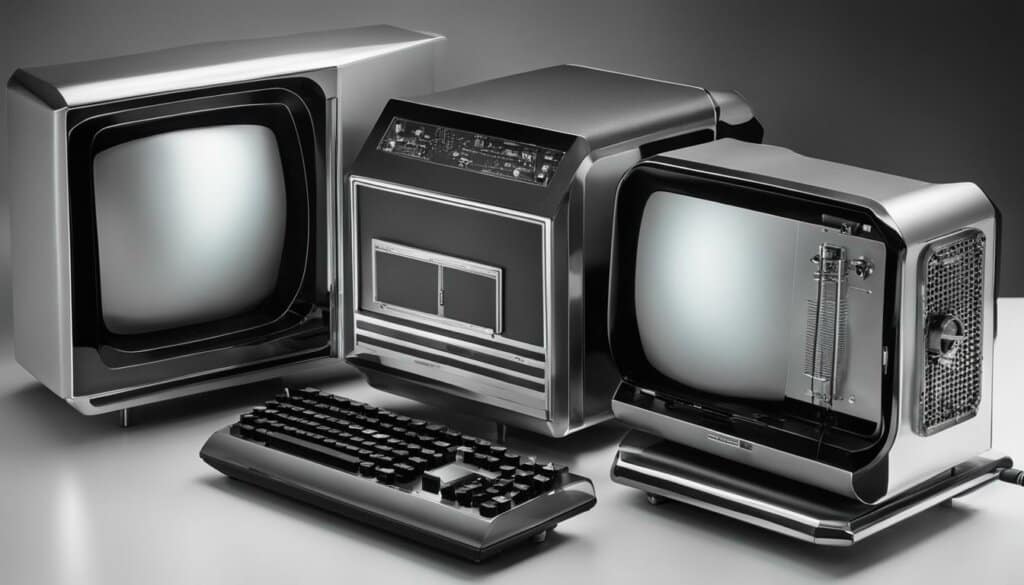
One notable electronic computer of the era was the Colossus, a machine developed by British codebreakers to decrypt German ciphers during World War II. The Colossus was among the first programmable electronic computers, utilizing vacuum tubes to perform calculations at unprecedented speeds. Its groundbreaking capabilities played a vital role in the Allies’ intelligence efforts and demonstrated the potential of electronic computing.
“The Colossus was a monumental achievement in electronic computing. It paved the way for future advancements and showcased the power of electronic systems in solving complex problems.” – Expert Opinion
Another notable achievement of the 1940s was the creation of ENIAC (Electronic Numerical Integrator and Computer), which is widely considered the world’s first general-purpose electronic computer. Developed at the University of Pennsylvania, ENIAC utilized vacuum tubes and punched card input/output systems to perform complex calculations. It marked a significant milestone in the development of mainframe computers and showcased the potential for electronic computing in various fields.
In parallel, the Atanasoff-Berry Computer, developed by physicist John Atanasoff and engineer Clifford Berry, made strides in using binary systems for computation. The Atanasoff-Berry Computer laid the foundation for digital computing and inspired subsequent innovations in computer architecture.
| Year | Computer | Key Features |
|---|---|---|
| 1944 | Colossus | First programmable electronic computer |
| 1946 | ENIAC | World’s first general-purpose electronic computer |
| 1942-1945 | Atanasoff-Berry Computer | Used binary systems for computation |
1950s: The First Commercial Computers
In the 1950s, the computer industry saw a major milestone with the introduction of the first commercially available computers. These machines marked the beginning of a new era, bringing computing technology into the business world and paving the way for further advancements.
One of the notable commercial computers of the time was the LEO (Lyons Electronic Office). Developed by J. Lyons and Co., a British food manufacturer, the LEO became the first computer to handle routine office jobs. It was a groundbreaking achievement that showcased the potential of computers in business operations.
Another significant development was the UNIVAC (Universal Automatic Computer), produced by the U.S. Census Bureau. The UNIVAC was the first mass-produced commercial computer and played a crucial role in data processing for various industries. Its capabilities demonstrated the growing impact of computers on a larger scale.
“The first commercial computers revolutionized the way businesses operated. They brought computational power to the office environment and opened up new possibilities for data processing and analysis.”
The IBM 701: A Breakthrough in Mainframe Computers
During this period, IBM also made its mark with the IBM 701. It was IBM’s first commercially successful mainframe computer and served as a foundation for the company’s future technological advancements. The IBM 701 was widely used in scientific research and business applications, showcasing the growing demand for computing power in various sectors.
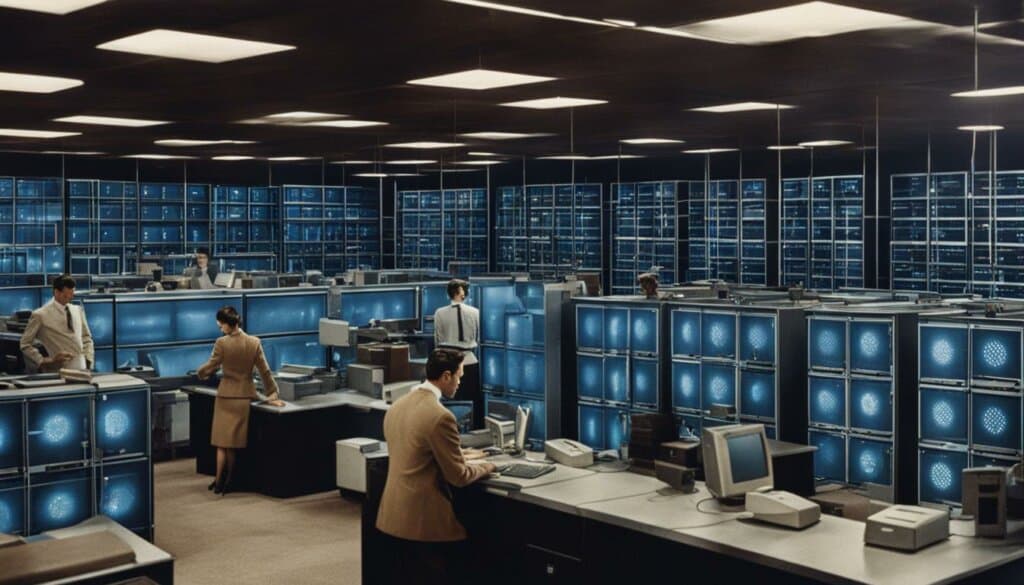
| Commercial Computers of the 1950s | Key Features |
|---|---|
| LEO (Lyons Electronic Office) | The first computer to run routine office jobs; brought computing technology into business operations. |
| UNIVAC (Universal Automatic Computer) | The first mass-produced commercial computer; played a crucial role in data processing for various industries. |
| IBM 701 | IBM’s first commercially successful mainframe computer; widely used in scientific research and business applications. |
The 1950s marked an important chapter in the evolution of computers, as commercial computers made their way into the business landscape. These early machines laid the foundation for the widespread adoption of computing technology, influencing industries and transforming the way businesses operated.
1960s: The Microchip and the Microprocessor
In the 1960s, the computer industry witnessed a groundbreaking development that would transform the world of computing: the invention of the microchip. Also known as an integrated circuit, the microchip revolutionized computer technology by integrating thousands of electronic components onto a single tiny chip of silicon. This breakthrough allowed for the development of smaller, more powerful, and more efficient computers.
One of the notable milestones in this era was the creation of the Intel 4004, the world’s first microprocessor. Introduced in 1971, the Intel 4004 marked a significant advancement in microprocessor technology, as it combined the central processing unit (CPU) and other essential components on a single chip. This innovation paved the way for the development of minicomputers and microcomputers, making computing more accessible and affordable to a wider audience.
The impact of microchips and microprocessors was far-reaching. They enabled the miniaturization of computers, leading to the development of personal computers in the following decades. Furthermore, microprocessors continued to evolve, with advancements in speed, power consumption, and capabilities. Today, microprocessors are found in a wide range of devices, from smartphones and tablets to smart appliances and wearable gadgets, driving the advancement of technology in various fields.
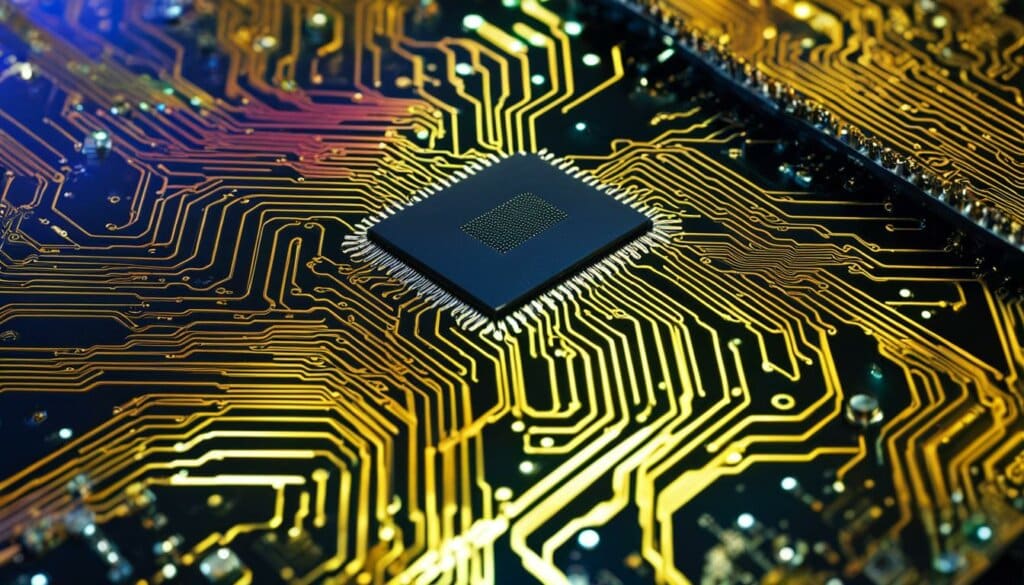
Advancements in Microchips and Microprocessors
The evolution of microchips and microprocessors over the years has been characterized by continuous advancements and improvements. With each new generation, microprocessors have become smaller, faster, and more efficient. These advancements have driven significant progress in computing technology and have enabled the development of more advanced and complex systems.
One of the key advancements in microprocessors is the transition from single-core to multi-core processors. This allowed for greater parallel processing, improving the overall performance and speed of computers. Today, it is common to find processors with multiple cores, ranging from dual-core to octa-core, in personal computers, smartphones, and other devices.
Another notable development is the integration of graphics processing units (GPUs) into microprocessors. Originally designed for rendering graphics in gaming and multimedia applications, GPUs now play an essential role in accelerating general-purpose computing tasks, such as machine learning and scientific simulations. This integration has led to significant advancements in these fields and has opened up new possibilities for computing applications.
| Advancements | Impact |
|---|---|
| Smaller size | Allows for the development of smaller and more portable computing devices |
| Higher speed | Enables faster processing and improved performance |
| Lower power consumption | Increases energy efficiency and extends battery life |
| Integration of GPU | Enhances graphics performance and enables new computing applications |
| Multi-core processors | Enables parallel processing and improves overall performance |
1970s: Personal Computers
In the 1970s, personal computers (PCs) began to emerge, marking a significant milestone in the evolution of computing. These early PCs, although limited by today’s standards, played a crucial role in shaping the computer revolution and laying the foundation for the devices we use today.
The Altair 8800, released in 1975, is often considered the first commercially successful personal computer. It was sold as a kit and required assembly, making it popular among hobbyists and enthusiasts. The Altair 8800 featured an Intel 8080 microprocessor and used switches and LEDs for input and output.
Another notable PC from this era was the Commodore PET (Personal Electronic Transactor), released in 1977. It featured a built-in keyboard and monitor, making it one of the first all-in-one computers. The Apple II, introduced the same year, revolutionized the PC industry with its color graphics and open architecture, allowing users to expand and customize their machines. The Tandy TRS-80, released in 1977, was also a popular choice, offering affordability and compatibility with a wide range of software.
| Personal Computers | Year | Notable Features |
|---|---|---|
| Altair 8800 | 1975 | Intel 8080 microprocessor, assembly kit |
| Commodore PET | 1977 | All-in-one design, built-in keyboard and monitor |
| Apple II | 1977 | Color graphics, open architecture |
| Tandy TRS-80 | 1977 | Affordability, compatibility |
These early PCs had a significant impact on society, bringing computing technology into homes and businesses. They sparked a wave of innovation and paved the way for the development of more powerful and accessible personal computers. Without the strides made in the 1970s, the modern computing landscape would look very different.
1980s-1990s: The Early Notebooks and Laptops
In the 1980s and 1990s, the world witnessed the birth of portable computers, heralding a new era of computing. These early portable devices paved the way for the notebooks and laptops we use today. One of the pioneering portable computers was the Osborne 1, introduced in 1981. Although it was bulky and heavy by today’s standards, weighing around 24 pounds, it was a game-changer for those who needed a portable computing solution.
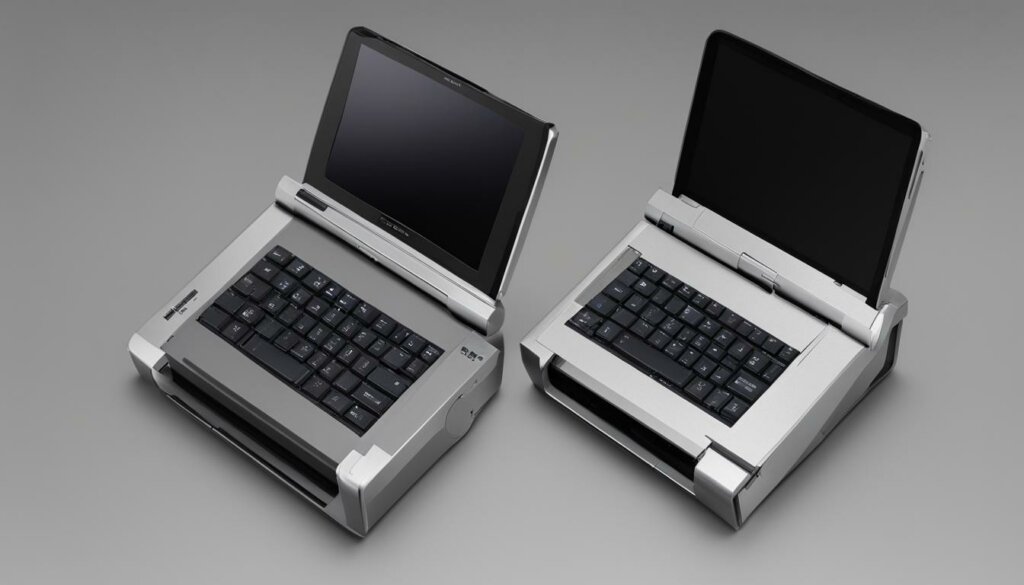
Another notable portable computer from this era was the Gavilan SC, marketed as a “laptop.” Released in 1983, it featured a full-sized keyboard, a built-in modem, and a unique clamshell design that could be closed to protect the screen and keyboard. These early portable computers introduced the concept of computing on the go, allowing users to work outside of traditional office settings and offering newfound flexibility.
To further understand the impact of portable computers, let’s take a closer look at the comparison table below that highlights key features and specifications of the Osborne 1 and the Gavilan SC:
| Portable Computer | Release Year | Weight | Screen Size | Operating System |
|---|---|---|---|---|
| Osborne 1 | 1981 | 24 pounds | 5″ | CP/M |
| Gavilan SC | 1983 | 14 pounds | 8″ | Gavilan DOS |
This period marked an important milestone in computer history, as portable computers became more accessible to a wider audience. The advancements made during the 1980s and 1990s laid the foundation for the sleek and lightweight notebooks and laptops we enjoy today, empowering us to work and stay connected wherever we go.
2000s-Present: Advancements in Mobility and Integration
In the 2000s and beyond, the world of computing has seen tremendous advancements in mobility and integration. With the emergence of mobile computing, smartphones and tablets have become an integral part of our daily lives. These portable devices provide us with the convenience of accessing information, communicating, and performing various tasks on the go. From checking emails to watching videos, mobile computing has revolutionized the way we interact with technology.
Another significant development in recent years is the rise of cloud computing. This technology allows us to store and access data and applications over the internet, eliminating the need for physical storage devices and increasing flexibility and scalability. With cloud computing, businesses can streamline their operations and individuals can enjoy seamless synchronization across devices. It has transformed the way we work, collaborate, and store information.
The Internet of Things (IoT) has also played a pivotal role in the integration of computers into our daily lives. IoT refers to the network of interconnected devices that collect and exchange data, enabling automation and smart control in various sectors. From smart homes and wearable devices to industrial automation and healthcare systems, the IoT has created a network of interconnected devices that make our lives more efficient and convenient.
The Impact of Mobility and Integration
The impact of mobility and integration in computing is far-reaching. It has transformed the way we communicate, work, and live. With the widespread adoption of smartphones and tablets, we can stay connected and productive wherever we go. Businesses have embraced mobile computing to enhance customer engagement, streamline processes, and gain a competitive edge.
Cloud computing has revolutionized the storage and processing of data, enabling businesses of all sizes to scale up or down as needed and access resources on demand. It has also provided individuals with the convenience of accessing their files and applications from any device with an internet connection. Cloud-based services have become the backbone of many industries, from online collaboration tools to on-demand entertainment streaming.
The Internet of Things has brought about a new era of connectivity, where everyday objects are interconnected and can communicate with each other. This has opened up a world of possibilities, from smart homes that can be controlled remotely to industrial systems that optimize efficiency and reduce downtime. The integration of computers into various aspects of our lives has made us more efficient, productive, and connected.
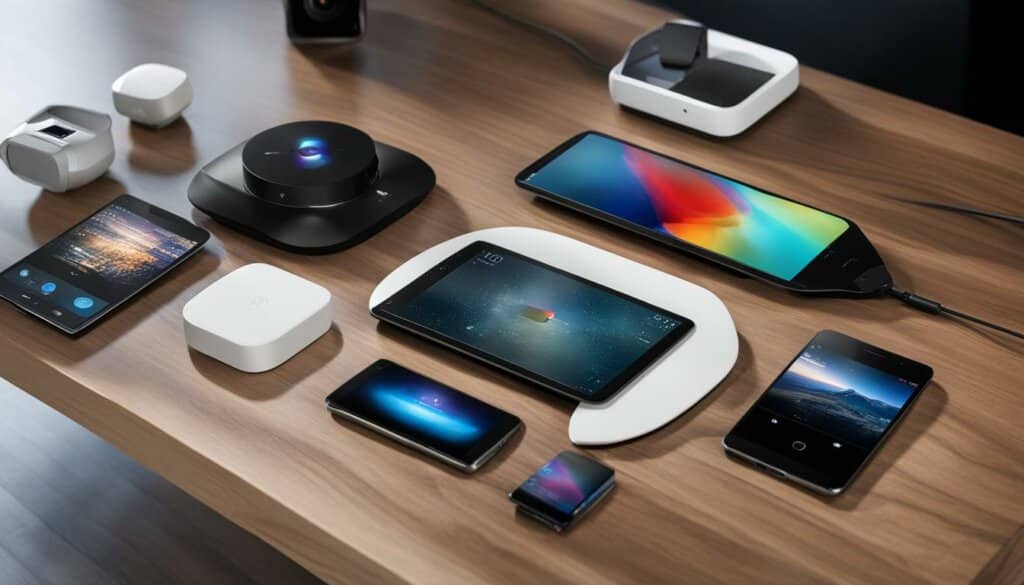
| Advancements in Mobility and Integration | Impact |
|---|---|
| Mobile Computing | Convenience of accessing information on the go |
| Cloud Computing | Streamlined operations and increased flexibility |
| Internet of Things (IoT) | Efficient automation and connectivity |
The Future of Computing: Quantum and AI
The future of computing holds exciting possibilities with the advancements in quantum computing and artificial intelligence. Quantum computers have the potential to solve complex problems at incredible speeds, revolutionizing industries such as cryptography and drug discovery. Artificial intelligence continues to expand its capabilities, enhancing human-machine interaction and powering innovations in various fields. The future of computing looks promising with the continued development of these cutting-edge technologies.
The field of quantum computing aims to harness the unique properties of quantum mechanics to perform computations that are currently beyond the capabilities of traditional computers. Unlike classical computers that use bits to represent information as 0s or 1s, quantum computers use quantum bits or qubits. Qubits can exist in a superposition of states, which allows for parallel processing and potentially massive computational power.
With the development of quantum computers, we could see significant advancements in areas such as cryptography, optimization, simulation, and machine learning. Quantum cryptography could provide unbreakable encryption, ensuring secure communication in a world where cyber threats are becoming increasingly sophisticated. Quantum optimization algorithms could revolutionize supply chain management, financial portfolio optimization, and other complex decision-making processes. Quantum simulation could enable scientists to model and study complex phenomena that are currently too challenging for classical computers to handle. And in the field of machine learning, quantum algorithms could accelerate training and inference tasks, opening up new possibilities for artificial intelligence.
| Advancements in Quantum Computing | Impact |
|---|---|
| Increased qubit count and improved coherence | Enables more complex calculations and simulations |
| Development of error correction techniques | Reduces errors and improves reliability |
| Improved quantum algorithms | Speeds up computations and optimization problems |
Artificial intelligence, on the other hand, focuses on creating computer systems that can perform tasks that typically require human intelligence, such as understanding natural language, recognizing images, and making decisions. The advancements in AI have been driven by the availability of big data, powerful computing resources, and advancements in algorithms, particularly deep learning.
As AI continues to evolve, we can expect to see advancements in areas such as natural language processing, computer vision, robotics, and autonomous systems. Natural language processing algorithms could enable more advanced voice assistants and language translation systems. Computer vision algorithms could improve image and video analysis, leading to applications in fields such as healthcare, autonomous vehicles, and surveillance. Robotics and autonomous systems could benefit from AI, enabling more advanced and capable machines that can adapt to their environment and perform complex tasks.
The future of computing is undoubtedly exciting, with quantum computing and AI leading the way. These technologies have the potential to transform industries, drive innovation, and solve some of the world’s most pressing problems. As researchers and engineers continue to push the boundaries of what is possible, we can anticipate a future where computers are even more powerful, intelligent, and integrated into our everyday lives.
The Impact of Processors: From Mainframes to Multi-core
Processors have played a pivotal role in the evolution of computers, driving advancements in computing technology and enabling the performance we experience today. From early mainframes to the multi-core processors of today, the development of processor architectures has shaped the way we interact with computers.
The evolution of processors can be seen in the speed and performance improvements over the years. As processor technology advanced, clock speeds have increased, allowing for faster data processing. From the early processors operating at a few megahertz to modern processors reaching gigahertz and beyond, the speed at which computations can be performed has drastically improved.
One significant step in processor evolution was the transition from single-core to multi-core processors. Multi-core processors allow for parallel processing, where multiple tasks can be executed simultaneously. This has led to improved multitasking capabilities and enhanced performance in tasks that can be divided into smaller sub-tasks.
Processor Architecture and its Impact
Processor architecture, the design and structure of a processor, has a significant impact on its performance and capabilities. Different architectures, such as x86, ARM, and PowerPC, have been used in various computing devices, each with its strengths and weaknesses.
Processor architecture also influences power efficiency, with newer architectures designed to optimize energy consumption. This has led to advancements in mobile computing, where battery life is a crucial factor. Processors have become more power-efficient, allowing for longer usage times on smartphones, tablets, and other portable devices.
The Future of Processors
The future of processors holds exciting possibilities for computing technology. Engineers and researchers are continually exploring new processor architectures, such as quantum processors, which have the potential to revolutionize computing with unprecedented computational power. The development of specialized processors for artificial intelligence (AI) and machine learning applications is also a key area of focus.
As processors continue to evolve, we can expect even greater advancements in computing technology. The impact of processors in computing cannot be overstated, driving the growth and innovation we see in various industries and transforming the way we interact with technology.
| Processor Generation | Main Features | Advancements |
|---|---|---|
| First Generation | Used in early mainframes | Basic processing capabilities |
| Second Generation | Improved processing power and speed | Introduction of integrated circuits |
| Third Generation | Advancements in microarchitecture | Higher clock speeds and improved performance |
| Fourth Generation | Introduction of multi-core processors | Enhanced multitasking capabilities |
| Fifth Generation | Focus on power efficiency | Optimization for mobile and low-power devices |
The evolution of processors has transformed the world of computing, from early mainframes to the multi-core processors we rely on today. As computing technology continues to advance, the impact of processors will continue to shape the future of technology.

Graphics Processing Units (GPUs) and Gaming
Graphics Processing Units (GPUs) have revolutionized the gaming industry, delivering immersive and visually stunning experiences. GPUs are specialized processors that handle complex graphics calculations, rendering lifelike environments, and realistic gameplay. With the evolution of GPUs, gaming has seen remarkable advancements in performance and graphics quality, pushing the boundaries of what is possible in gaming.
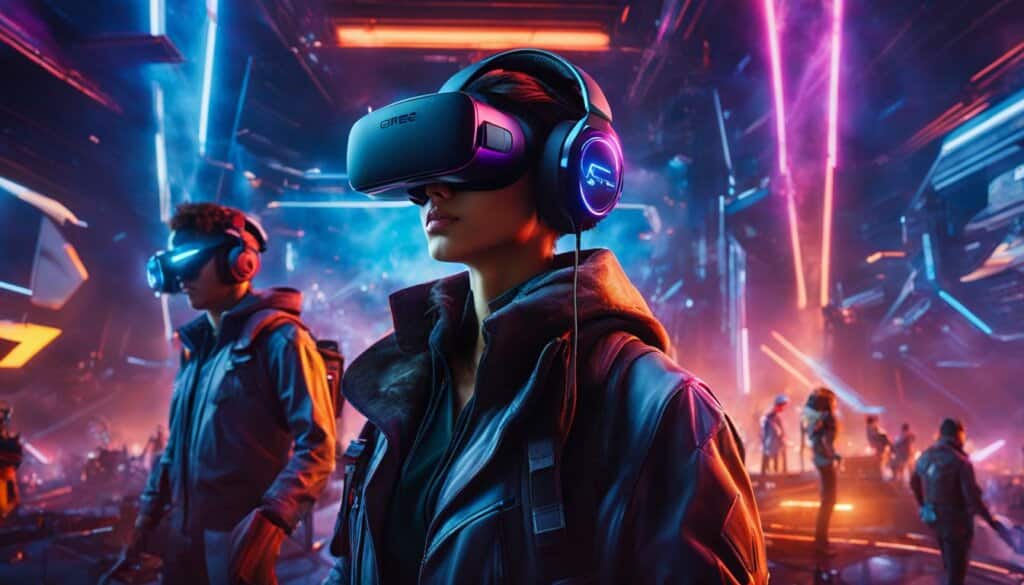
Over the years, GPUs have evolved to meet the increasing demands of gamers. GPU evolution has seen significant improvements in processing power, memory bandwidth, and efficiency. From the early days of 2D gaming to the current era of photorealistic 3D graphics, GPUs have played a vital role in shaping the gaming landscape.
In addition to raw performance, innovations in processor cooling have been crucial to ensure stable and efficient gaming experiences. Advanced cooling solutions such as liquid cooling, heat pipes, and dual-fan designs have allowed GPUs to operate at optimal temperatures, preventing thermal throttling and optimizing performance. Effective cooling solutions enable gamers to push their hardware to the limits without sacrificing stability or longevity.
The Impact of GPUs in Gaming
The impact of GPUs in gaming cannot be overstated. GPUs have not only transformed the visual fidelity of games but also enabled new gameplay mechanics and features. Real-time ray tracing, for example, simulates the behavior of light in a virtual environment, resulting in more realistic reflections, shadows, and lighting effects. This technology, made possible by powerful GPUs, enhances immersion and adds a new level of visual fidelity to gaming experiences.
Gaming and processors go hand in hand, with GPUs being the driving force behind the industry’s technological advancements. As game developers continue to push the boundaries of what is possible in gaming, GPUs will play a fundamental role in delivering the necessary processing power to support these innovative experiences. The ongoing evolution of GPUs promises even more stunning graphics and immersive gameplay in the future.
The Role of Processors in Various Fields
Processors, the heart and brain of computing systems, play a critical role in various fields, shaping the way we interact with technology and advancing numerous industries. From cloud computing to robotics and biocomputing to embedded systems, processors have revolutionized these sectors, enabling innovative solutions and transformative advancements.
Processors in Cloud Computing
In the realm of cloud computing, processors power the infrastructure that supports vast amounts of data processing and storage. They handle complex calculations and ensure seamless communication between servers and clients. With their high-speed processing capabilities, processors make cloud computing efficient and scalable, allowing businesses to harness the power of the cloud for storage, computation, and information sharing.
Processors in Robotic Applications
Robots rely on processors to perform complex tasks and make real-time decisions. Processors drive the sensors, actuators, and computational units in robots, enabling them to perceive and interact with their environment. From industrial automation to autonomous vehicles, processors play a pivotal role in enhancing the efficiency, accuracy, and safety of robotic applications, revolutionizing industries and transforming the way we work and live.
Processors in Biocomputing
Biocomputing blends biology and computing to develop solutions for biological data analysis, biomolecular simulations, and genetic research. Processors are crucial in powering the computational algorithms and simulations used in biocomputing, enabling researchers to analyze complex biological systems and uncover valuable insights. By leveraging the processing power of computers, biocomputing accelerates the discovery of new drugs, aids in personalized medicine, and advances our understanding of the intricate mechanisms of life.
Processors in Embedded Systems
Embedded systems, found in various devices and appliances, rely on processors to perform specific functions within a limited environment. Processors in embedded systems are optimized for low power consumption and efficient execution, allowing them to control and monitor critical operations in devices such as smartphones, wearable devices, home automation systems, and automotive electronics. Their integration into embedded systems has transformed everyday objects into smart and interconnected devices, enhancing our convenience, comfort, and productivity.
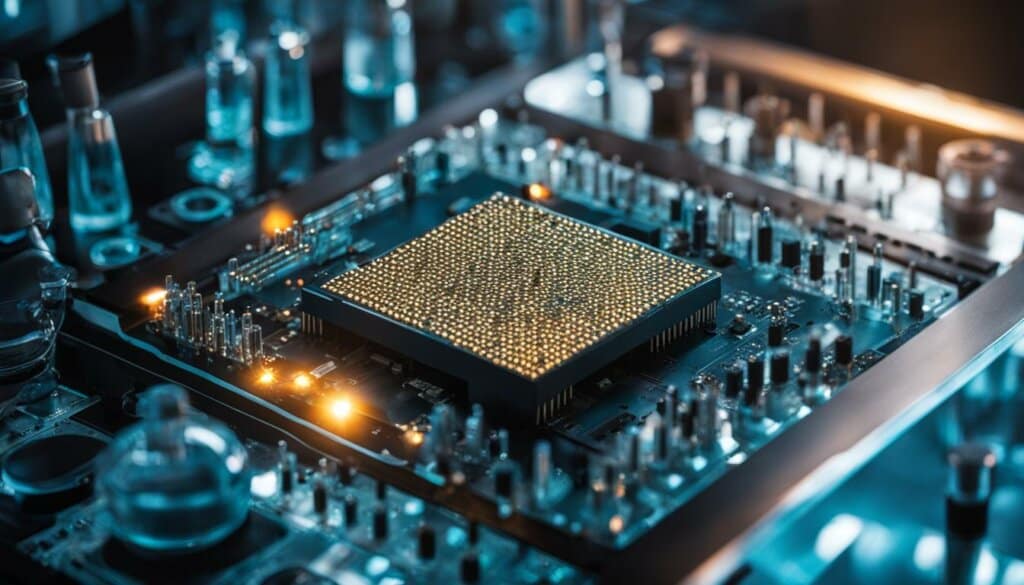
The Impact of Processors
The impact of processors in various fields cannot be overstated. Their continuous advancements have driven the growth and innovation across industries, empowering us to leverage the full potential of technology. Through their exceptional processing power, processors have revolutionized cloud computing, enabled the development of advanced robotic applications, propelled breakthroughs in biocomputing, and transformed everyday objects into smart and interconnected devices. As processors continue to evolve, we can expect further advancements in these fields, unlocking new possibilities and shaping the future of technology.
Conclusion
The evolution of computers has been an incredible journey, spanning centuries and shaping the world we live in today. From the early mechanical computers of the 1800s to the powerful processors and interconnected systems of the present, computers have undergone significant advancements that have revolutionized industries and transformed our daily lives.
Throughout history, milestones such as the invention of electronic computers in the 1940s, the rise of personal computers in the 1970s, and the development of portable devices in the 1980s and 1990s have propelled the growth of computing technology.
Looking into the future, quantum computing and artificial intelligence hold immense potential for further advancements in the field. The integration of processors into various industries, including cloud computing, robotics, and biocomputing, demonstrates the versatility and impact of these technologies.
In conclusion, the evolution of computers has been a remarkable journey of innovation and progress. With each passing decade, new breakthroughs and advancements have propelled the computer industry forward, enabling us to accomplish tasks that were once unimaginable. As we embrace the future, the possibilities for further evolution in computing technology are limitless.
FAQ
What is the history of computers?
The history of computers can be traced back to the 1800s, with early mechanical computers like Charles Babbage’s Analytical Engine. Since then, computers have undergone significant changes, from the invention of the first electronic computers during World War II to the development of microchips and microprocessors in the 1960s.
What were the early mechanical computers?
Early mechanical computers included Charles Babbage’s Babbage Engines such as the Difference Engine and Analytical Engine. While these machines were never fully completed, their designs laid the foundation for concepts used in modern computers. The Z1, created by Konrad Zuse in 1938, was one of the first automatic computing machines and used mechanical internals for calculations.
What were electro-mechanical computers?
Electro-mechanical computers emerged in the 1930s and utilized relays and vacuum tubes as switches. The Differential Analyzer, for example, employed electric motors for calculations. These computers were either analog or digital and played a crucial role in shaping the technology and concepts used in modern computers.
What were the first electronic computers?
The development of electronic computers took place in the 1940s, with significant advancements during World War II. The Colossus, an electronic computer developed to decrypt German codes, and The Baby (Manchester Small-Scale Experimental Machine) were notable examples. The era also saw the creation of mainframe computers like the ENIAC and the Atanasoff-Berry Computer, which utilized binary systems.
When did commercial computers become available?
The 1950s saw the introduction of the first commercially available computers. The LEO (Lyons Electronic Office) became the first computer to run routine office jobs, while the UNIVAC, produced by the U.S. Census Bureau, was the first mass-produced commercial computer. IBM also made a significant impact with the IBM 701, the company’s first mainframe computer.
What was the impact of microchips and microprocessors?
The 1960s witnessed the advent of the microchip, also known as the integrated circuit, which revolutionized computer technology. This led to the development of minicomputers and microcomputers, making computing more accessible and affordable. Microchips and microprocessors played a vital role in the development of personal computers and paved the way for smaller, more powerful devices.
When did personal computers become popular?
The 1970s saw the emergence of personal computers, with notable models like the Altair 8800, Commodore PET, Apple II, and Tandy TRS-80. These early PCs laid the foundation for the computer revolution and became more accessible to the general public. The rise of personal computers marked a significant shift in computing technology.
What were the early notebooks and laptops?
In the 1980s and 1990s, the development of portable computers led to the advent of notebooks and laptops. The Osborne 1, introduced in 1981, was one of the first commercially available portable computers. These early portable computers paved the way for more compact and easily portable devices.
What are the advancements in computing technology today?
In the 2000s and beyond, computing technology has focused on mobility and integration. The rise of smartphones and tablets brought computing power to the palm of our hands. Advancements in cloud computing and the Internet of Things (IoT) have further integrated computers into various aspects of our lives.
What is the future of computing?
The future of computing holds exciting possibilities with advancements in quantum computing and artificial intelligence. Quantum computers have the potential to solve complex problems at incredible speeds, while artificial intelligence continues to enhance human-machine interaction and power innovations in various fields.
What has been the impact of processors in computing?
Processors have played a vital role in the evolution of computers, from early mainframes to today’s multi-core processors. Over time, processor architectures have become more advanced, resulting in increased speed and performance. The impact of processors in computing cannot be overstated.
How have GPUs influenced gaming?
Graphics Processing Units (GPUs) have become integral to the gaming industry, providing the processing power needed to handle complex graphics and rendering. The evolution of GPUs has led to significant advancements in gaming experiences, with lifelike graphics and realistic gameplay.
What are the other applications of processors?
Processors are not limited to traditional computing applications but have found their way into various fields. In cloud computing, processors power the infrastructure that supports vast amounts of data processing. Processors also play a crucial role in robotics, biocomputing, and embedded systems, enabling advancements in automation and biomedical technologies.
Source Links
- https://www.insider.com/how-computers-evolved-history-2019-9
- https://www.livescience.com/20718-computer-history.html
- https://www.webfx.com/blog/web-design/the-history-of-computers-in-a-nutshell/

